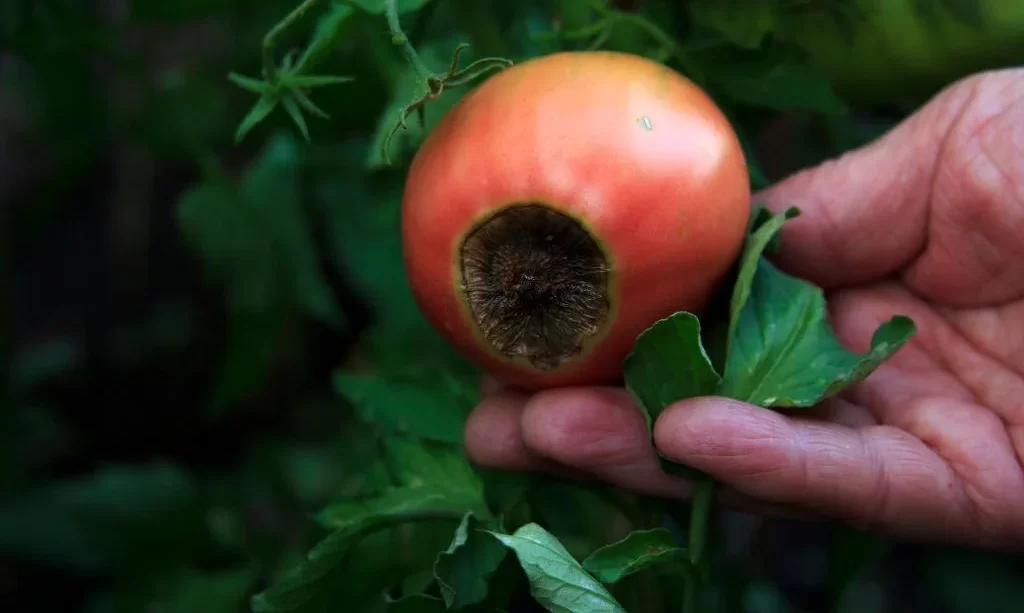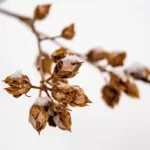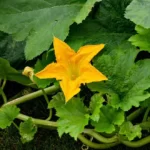Imagine eagerly tending to your tomato plants, nurturing them with care, only to discover an unwelcome sight – tomatoes marred by dark, sunken spots on their blossom ends. This frustrating phenomenon is known as blossom end rot, a common issue that plagues gardeners and leaves them with a perplexing question: Can you still eat tomatoes affected by this condition? In this guide, we will delve into the world of blossom end rot, unraveling its mysteries and providing you with the knowledge you need to make informed decisions about your tomato harvest. So, let’s start by understanding the ins and outs of this tomato ailment.
Blossom End Rot
Blossom end rot is a tomato grower’s nemesis, and it’s crucial to grasp what causes it and how it manifests:
- The Culprit: At the heart of blossom end rot lies a calcium deficiency in the developing tomato fruit. Calcium is essential for cell wall development, and when it’s lacking, the tomato can’t form properly, resulting in the characteristic sunken, dark spots at the blossom end.
- Early Warning Signs: Recognizing blossom end rot early is key. It typically begins as a small, water-soaked area on the blossom end of the tomato. As the condition progresses, this spot darkens and becomes leathery.
- Causes Beyond Calcium: While calcium deficiency is the primary trigger, other factors contribute to the development of blossom end rot. Inconsistent watering, especially irregular watering patterns, can disrupt calcium uptake by the plant’s roots, exacerbating the issue.
Understanding the mechanics of blossom end rot is the first step in determining whether you can salvage affected tomatoes for consumption.
Determining Edibility
Now that we’ve uncovered the causes and symptoms of blossom end rot, the pressing question remains: Are tomatoes affected by this condition safe to eat?
- Yes, but with a Caveat: The good news is that tomatoes with blossom end rot are generally safe for consumption, with a caveat. While the affected portion of the tomato is unpalatable and visually unappealing, the rest of the fruit is perfectly fine to eat.
- Cutting Away the Problem: To make these tomatoes edible, you’ll need to employ a simple solution – cut away the affected part. Use a clean knife to trim off the dark, sunken area, ensuring you remove a sufficient margin around it. This leaves you with a wholesome, safe tomato to enjoy.
- Cooking Can Help: Another way to make the most of tomatoes with blossom end rot is to incorporate them into cooked dishes. Cooking can soften the affected part, making it less noticeable and improving the overall taste and texture.
Proper Preparation
When it comes to enjoying tomatoes afflicted by blossom end rot, proper preparation is key to ensure a pleasant dining experience:
- Cutting Technique: Use a sharp knife to cut out the affected area. Make sure to discard the entire darkened portion, leaving only the healthy, fleshy part of the tomato. This process ensures that you’re left with edible and safe tomato flesh.
- Cooking Options: If you choose to cook the tomatoes, consider using them in sauces, soups, stews, or salsas where the visual imperfections will be less noticeable. Cooking can also help mask any textural differences caused by the condition.
- Balanced Flavors: Be mindful of the flavor of the tomatoes. Blossom end rot can affect taste, but in many cases, the flavor remains enjoyable, especially when incorporated into savory dishes.
By following these steps and proper preparation techniques, you can make the most of your tomato harvest, even if blossom end rot has made an appearance. It’s a practical way to reduce food waste and still relish the fruits of your gardening labor.
Prevention and Remediation
Preventing blossom end rot in your tomato plants is a proactive approach to ensure a bountiful and unblemished harvest:
- Consistent Watering: To avoid calcium uptake issues, maintain consistent watering practices. Tomatoes require even moisture levels, so aim to water them regularly and evenly, particularly during dry spells. Drip irrigation or soaker hoses can be helpful in this regard.
- Soil Amendment: Conduct soil tests to check calcium levels in your garden soil. If calcium deficiency is identified, amend the soil with calcium-containing products like gypsum or lime. This helps provide an adequate supply of calcium to the growing tomatoes.
- Mulching: Apply mulch around your tomato plants to help regulate soil moisture and temperature. Mulch acts as a protective barrier, reducing the risk of moisture fluctuations that can contribute to blossom end rot.
- Adjusting pH: Ensure that the soil pH is in the optimal range for calcium uptake, typically around 6.5 to 6.8 for most tomato varieties. Adjusting soil pH can help improve calcium availability to your plants.
- Regular Monitoring: Keep a watchful eye on your tomato plants throughout the growing season. Promptly address any signs of irregular growth or nutrient deficiencies to prevent blossom end rot from taking hold.
If, despite your best efforts, you still encounter blossom end rot, don’t despair. Remediation methods, like amending the soil with calcium and adjusting your watering practices, can help correct the issue and improve future harvests.
- This bag has been repaired due to damages to packaging during warehouse handling. Derived from the shell of the cocoa bean, natural dark, fade resistant color and pleasing cocoa aroma
- Very lightweight and easy to spread and will not burn vegetation
- Speeds soil warm-up in the spring and protects perennial root structures
- PLEASE NOTE this product is unsafe for dogs and is not for human consumption
Benefits of Using Affected Tomatoes
While dealing with tomatoes afflicted by blossom end rot may seem frustrating, there are several benefits to using them:
- Reduction of Food Waste: Using affected tomatoes reduces food waste in your garden. Instead of discarding them, you can salvage the edible portions, minimizing your environmental footprint.
- Cost Savings: Every tomato saved is money saved. By using tomatoes with blossom end rot, you maximize the return on your gardening investment, as you won’t need to purchase additional tomatoes.
- Cooking Versatility: These tomatoes can still be used in a wide range of dishes. Their slightly altered texture and flavor are often indistinguishable in cooked recipes, making them ideal for sauces, stews, and more.
Conclusion
In conclusion, blossom end rot may be an unwelcome guest in your tomato garden, but it doesn’t have to result in wasted produce. Understanding that the unaffected portions of tomatoes with this condition are safe to eat and learning how to properly prepare them can help you enjoy a productive harvest while reducing food waste.
Furthermore, prevention methods, such as consistent watering, soil amendment, and monitoring, can go a long way in safeguarding your future tomato crops. By taking these steps, you’ll be better equipped to prevent blossom end rot from affecting your tomatoes and ensure a more bountiful and visually appealing harvest.
So, the next time you encounter tomatoes with blossom end rot, don’t despair – consider them an opportunity to savor the flavor of homegrown goodness and to be a conscientious gardener committed to reducing food waste.





